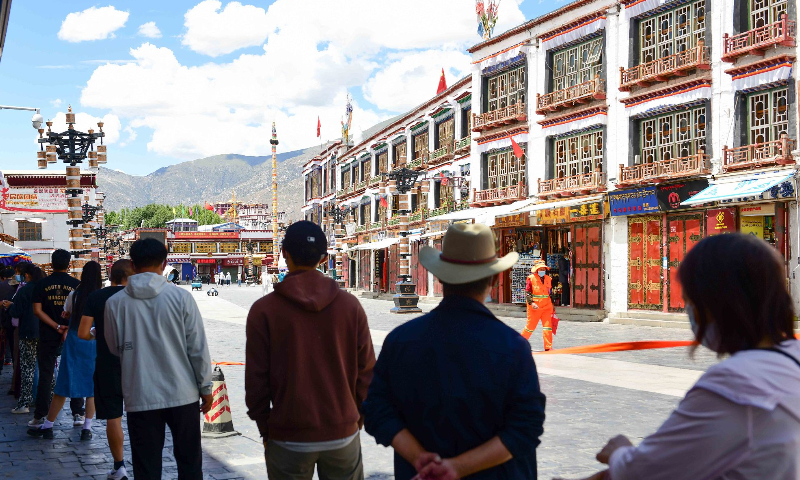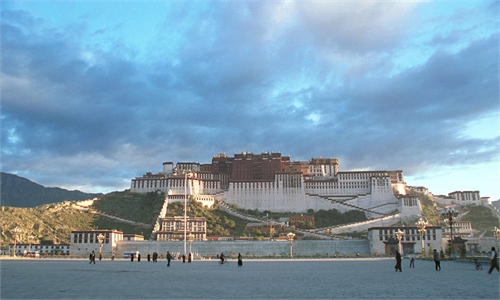
Residents in Lhasa, capital of Southwest China's Xizang (Tibet) Autonomous Region, line up to take COVID-19 nucleic acid tests on August 9, 2022. Photo: VCG
After more than a month of its first large-scale battle against COVID-19, Lhasa in Southwest China's Xizang Autonomous Region has partially resumed normal production and work, with the city districts being relaxed in phases.
Sporadic customers wearing masks were delighted to show up in supermarkets, pharmacies and restaurants in some parts of low-risk streets and communities in Lhasa, as the city made the decision to gradually lift COVID-19 restrictions in phases after epidemic control measures have seen achievements, local media reported.
Data released by the Xizang health commission on Tuesday afternoon showed that the region reported 16 confirmed and 160 asymptomatic cases the previous day, and another 51 asymptomatic cases on Tuesday. The number of new cases in recent weeks have remained low, in contract with the number of cases in the initial outbreak in August.
An official notice released by the local government read that businesses in low-risk areas including supermarkets and pharmacies could open their doors to customers. Residents could leave their communities with permits.
Several local residents in Lhasa reached by the Global Times said people were thrilled to hear the news. The owner of a photography shop in Lhasa told the Global Times he looks forward to opening his business soon, as the tourism season for Xizang is about to come next month.
Commodities including food and other daily necessities can basically meet residents' needs thanks to the local government's full support to ensure adequate supplies.
Work in the first batch of low-risk regions in Lhasa had resumed as early as September 8. Local media reported that some 74 businesses such as hair salons, restaurants and supermarkets in a community of Chengguan district had opened their businesses.
Local officials at Tuesday's press conference said that some 73 construction programs had resumed work. To ease the financial burden of some small-scale and individual businesses, the local government cut more than 236 million yuan ($33 million) in rent for more than 3,000 tenants.
However, the city remains cautious about entirely lifting restrictions. Tourism sites and restaurants remain shut. Schools have not resumed classes, according to the notice.
Meanwhile, in another city in Xizang, the Xigaze government announced on Monday that the city had achieved dynamic-zero cases among communities, as recent new COVID-19 cases had all come from quarantined groups. After complex evaluation, Xigaze will also gradually resume work in batches.
But the local government of Xigaze stressed that achieving dynamic-zero cases doesn't mean the risk for COVID-19 has been cleared. The situation of epidemic prevention and control is still grim and complex, and the risk of hidden transmission still exists. Efforts should continue to guard the hard-won achievements of epidemic control until final success is obtained, local authorities stressed.
Xizang region recorded 22 COVID-19 cases on August 7, ending the region's 920-day record of no cases. Subsequently, static management was imposed in both Xigaze and Lhasa.
The cases detected in Lhasa were believed to be a family cluster infection caused by the imported Omicron subvariant BA.2.76.
Huang Ziting contributed to the story


